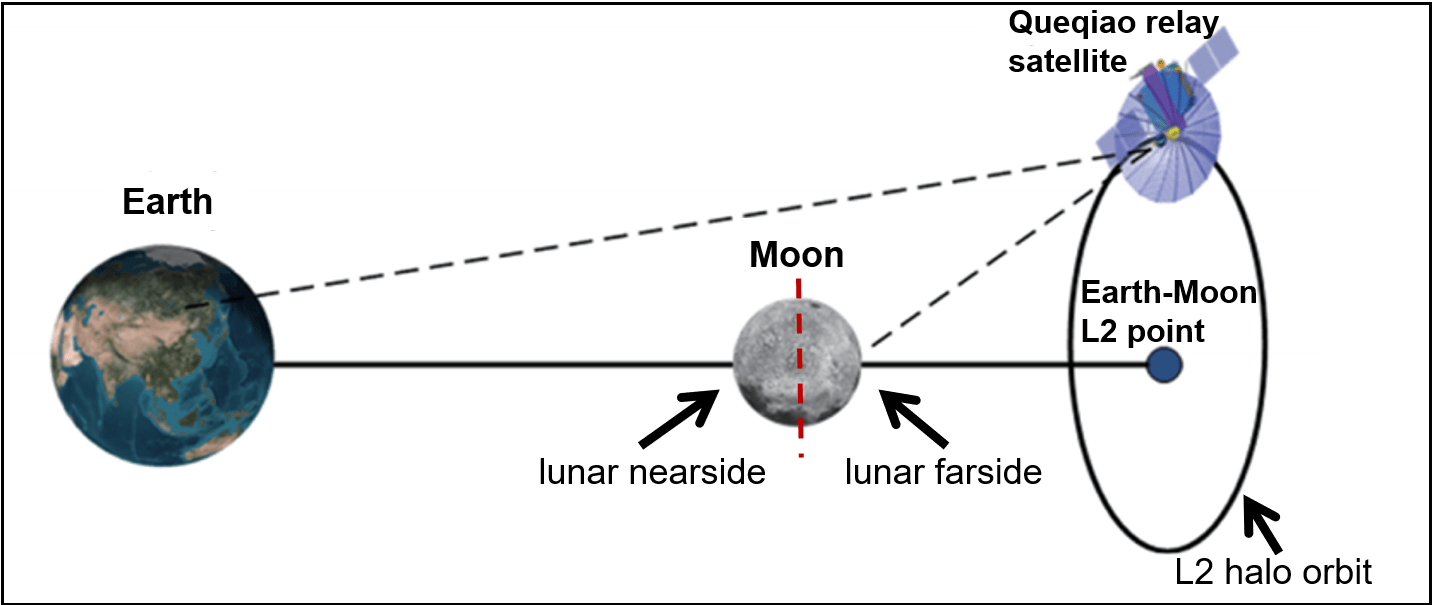The Chang’e-4 mission, the fourth installment in the Chinese Lunar Exploration Program, has made some significant achievements since it launched in December of 2018. In January of 2019, the mission lander and its Yutu 2 (Jade Rabbit 2) rover became the first robotic explorers to achieve a soft landing on the far side of the Moon. Around the same time, it became the first mission to grow plants on the Moon (with mixed results).

In the latest development, the Netherlands-China Low Frequency Explorer (NCLE) commenced operations after a year of orbiting the Moon. This instrument was mounted on the Queqiao communications satellite and consists of three 5-meter (16.4 ft) long monopole antennas that are sensitive to radio frequencies in the 80 kHz – 80 MHz range. With this instrument now active, Chang’e-4 has now entered into the next phase of its mission.
The radio observatory is the result of collaboration between the Netherlands Institute for Radio Astronomy (ASTRON) and the China National Space Agency (CNSA). ASTRON has a long history of conducting radio astronomy, which includes the operation of one of the largest radio telescopes in the world – the Westerbork Synthesis Radio Telescope (WSRT), which is also part of the European Very Long Baseline Interferometry Network (EVN).
 This series of three photographs was taken during the unfolding of an antenna on the Queqiao satellite. Credit and ©: Marc Klein Wolt/Radboud University
This series of three photographs was taken during the unfolding of an antenna on the Queqiao satellite. Credit and ©: Marc Klein Wolt/Radboud UniversityThe NCLE is the first observatory built by the Netherlands and China to conduct radio astronomy experiments while orbiting on the far side of the Moon. This location is considered ideal for such experiments since it is removed from any terrestrial radio interference. It is for this reason that Queqiao has had to act as a communications relay with the Chang’e-4 mission since radio signals cannot reach the far side of the Moon directly.
While the NCLE is capable of mounting multiple forms of scientific research, its main purpose is to conduct groundbreaking experiments in radio astronomy. Particularly, the NCLE will gather data in the 21-cm (8.25 inch) emission range, which corresponds with the earliest periods in cosmic history.
These are otherwise known as the Dark Ages and Cosmic Dawn, which have previously been inaccessible to astronomers. By examining light from the earliest periods of the Universe, astronomers will finally be able to answer some of the most enduring questions about the Universe. These include when the first stars and galaxies formed, as well as the influence of Dark Matter and Dark Energy on cosmic evolution.
Until now, the Queqiao satellite was primarily a communications relay between the lander and rover and mission controllers on Earth. But with the primary goals of the Chang’e-4 mission now achieved, the China National Space Agency (CNSA) has entered into the next phase of operations, which is to operate a radio observatory on the far side of the Moon.
 https://commons.wikimedia.org/w/index.php?curid=11885244" />Evolution of the Universe, including CMB, the Dark Ages, and the Afterglow Light Pattern. Credit: NASA/WMAP/Wikipedia Commons/Cherkash
https://commons.wikimedia.org/w/index.php?curid=11885244" />Evolution of the Universe, including CMB, the Dark Ages, and the Afterglow Light Pattern. Credit: NASA/WMAP/Wikipedia Commons/CherkashAs Marc Klein Wolt, the Managing Director of the Radboud Radio Lab and leader of the Dutch team, expressed:
“Our contribution to the Chinese Chang’e 4 mission has now increased tremendously. We have the opportunity to perform our observations during the fourteen-day-long night behind the moon, which is much longer than was originally the idea. The moon night is ours, now.“
The unfolding of the antennas is the culmination of three years of hard work and the demonstration of this technology is expected to pave the way for new opportunities for radio instruments in space. In addition to scientists with ASTRON and the CNSA, there is no shortage of people around the world who are eagerly awaiting the NCLE’s first radio measurements.
Professor Heino Falcke, the chair of astrophysics and radio astronomy at Radboud University, is also the scientific leader of the Dutch-Chinese radio telescope. As he explained:
“We are finally in business and have a radio-astronomy instrument of Dutch origin in space. The team has worked incredibly hard, and the first data will reveal how well the instrument truly performs.”
The deployment of the instrument was meant to happen sooner and the year-long wait behind the Moon is believed to have had an effect on the antennas. Initially, the antennas unfolded smoothly but the progress became increasingly sluggish as time went on. As a result, the team decided to collect data first from the partially-deployed antennas first and may decide to unfold them further later.
At their current, shorter deployment, the instrument is sensitive to signals from roughly 13 billion years ago – aka. about 800 million years after the Big Bang. Once the antennas are unfolded to their full length, they will be able to capture signals from just after the Big Bang. This will allow astronomers to see the first stars being born and star clusters coming together to form the very first galaxies.
The first light in the Universe and the answers to some of the most profound questions will finally be accessible!

Acum există un radiotelescop operațional pe partea îndepărtată a Lunii
Misiunea Chang’e-4 , a patra tranșă din Programul chinez de explorare lunară, a realizat câteva realizări semnificative de la lansarea sa în decembrie 2018. În luna ianuarie 2019, misiunea a debarcat și roverul său Yutu 2 (Jade Rabbit 2) ce, împreună cu predecesorul, au devenit primii exploratori robotici care au realizat o aterizare reușită pe partea nevăzută a Lunii. De asemenea, a devenit prima misiune care a cultivat plante pe Lună (cu rezultate controversate).
De asemenea, Netherlands-China Low Frequency Explorer (NCLE) a început operațiunile de activare după un an de orbitare a Lunii. Acest instrument a fost montat pe satelitul de comunicații Queqiao și este format din trei antene monopole lungi de 5 metri (16,4 ft) care sunt sensibile la frecvențele radio din intervalul 80 kHz – 80 MHz. Cu acest instrument activ acum, Chang’e-4 a intrat acum în următoarea fază a misiunii sale.
Observatorul radio este rezultatul colaborării dintre Institutul olandez de radio-astronomie (ASTRON) și Agenția Națională Spațială din China (CNSA). ASTRON are o mare expertiză în radio astronomie, care include funcționarea unuia dintre cele mai mari radiotelescoape din lume – Westerbork Synthesis Radio Telescope (WSRT), care face parte, de asemenea, din European Very Long Baseline Interferometry Network (EVN).
NCLE este primul observator construit de Olanda și China pentru a efectua experimente de radio-astronomie în timp ce orbitează partea nevăzută a Lunii. Această locație este considerată ideală pentru astfel de experimente, deoarece este îndepărtată de orice interferență radio terestră. Din acest motiv, Queqiao a trebuit să acționeze ca un releu de comunicații cu misiunea Chang -’4-4, deoarece semnalele radio nu pot ajunge direct în partea îndepărtată a Lunii.
Deși NCLE este capabil să efectueze o gamă largă de cercetări științifice, scopul său principal este de a efectua experimente inovatoare în radio astronomie. NCLE va avea ca prioritate strângerea de date privind emisiile radio din banda de 21 cm (8,25 inci), care corespund cu celor mai timpurii perioade din istoria cosmică. Acestea sunt de altfel cunoscute sub numele de Evul Întunecat și Zorii Cosmici, care anterior au fost inaccesibile astronomilor. Examinând lumina din primele perioade ale Universului, astronomii vor putea în cele din urmă să răspundă la unele dintre cele mai persistente întrebări despre Univers. Acestea includ când s-au format primele stele și galaxii, precum și influența materiei întunecate și a energiei întunecate asupra evoluției cosmice.
Până acum, satelitul Queqiao era în primul rând un releu de comunicații între lander, rover și controlorii de misiune de pe Pământ. Însă, cu obiectivele principale ale misiunii „4” ale Chang acum realizate, Agenția Națională Spațială a Chinei (CNSA) a intrat în următoarea fază de operațiuni, care este să opereze un observator radio în partea îndepărtată a Lunii.
„Contribuția noastră la cea de-a 4 misiune a Chinei Chang s-a amplificat extraordinar. Acum avem ocazia să ne executăm observațiile în timpul nopții de paisprezece zile din spatele lunii, care este mult mai lung decât a fost planificat inițial. Noaptea lunară este acum a noastră.”
Desfășurarea antenelor este punctul culminant al trei ani de muncă asiduă, iar demonstrația acestei tehnologii ar trebui să deschidă calea către noi oportunități pentru instrumentele radio în spațiu. Pe lângă oamenii de știință ASTRON și CNSA, astronomi din întreaga lume așteaptă cu nerăbdare primele măsurători radio ale NCLE.
Profesorul Heino Falcke, de la catedra de astrofizică și astronomie radio a Universității Radboud, care este, de asemenea, liderul științific al radiotelescopului olandezo-chinez a explicat:
„Suntem în sfârșit în cărți și avem un instrument radio-astronomic de origine olandeză, în spațiu. Echipa a lucrat incredibil, iar primele date ne vor dezvălui cât de bine funcționează instrumentul. ”
Desfășurarea instrumentului a fost gândită să se întâmple mai devreme, iar așteptarea pe tot parcursul anului în spatele Lunii se crede că a avut un oarece efect asupra antenelor. Inițial, antenele s-au desfășurat lin, dar progresele au devenit tot mai lente pe măsură ce timpul a trecut. Drept urmare, echipa a decis ca mai întâi să colecteze datele de la antenele parțial dislocate și poate decide să dezvăluie rezultatele mai târziu.
La implementarea sa actuală, mai scurtă, instrumentul este sensibil la semnalele cu vechimea de aproximativ 13 miliarde de ani (la aproximativ 800 de milioane de ani după Big Bang). Odată ce antenele vor fi desfășurate la întreaga lungime, vor putea să capteze semnale imediat următoare Big Bang-ului. Acest lucru va permite astronomilor să vadă primele stele care se nasc și grupuri de stele care se reunesc pentru a forma primele galaxii.
Prima lumină din Univers precum și răspunsurile la unele dintre cele mai profunde întrebări vor fi în sfârșit accesibile!
***

Comentarii